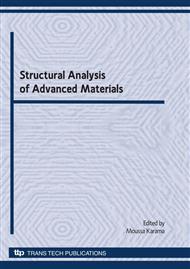p.83
p.91
p.101
p.111
p.121
p.131
p.137
p.147
p.157
Effect of Ductile Damage Evolution in Sheet Metal Forming: Experimental and Numerical Investigations
Abstract:
The numerical simulation based on the Finite Element Method (FEM) is widely used in academic institutes and in the industry. It is a useful tool to predict many phenomena present in the classical manufacturing forming processes such as necking, fracture, springback, buckling and wrinkling. But, the results of such numerical model depend strongly on the parameters of the constitutive behavior model. In the first part of this work, we focus on the traditional identification of the constitutive law using oriented tensile tests (0°, 45°, and 90° with respect to the rolling direction). A Digital Image Correlation (DIC) method is used in order to measure the displacements on the surface of the specimen and to analyze the necking evolution and the instability along the shear band. Therefore, bulge tests involving a number of die shapes (circular and elliptic) were developed. In a second step, a mixed numerical–experimental method is used for the identification of the plastic behavior of the stainless steel metal sheet. The initial parameters of the inverse identification were extracted from a uniaxial tensile test. The optimization procedure uses a combination of a Monte-Carlo and a Levenberg-Marquardt algorithm. In the second part of this work, according to some results obtained by SEM (Scaning Electron Microscopy) of the crack zones on the tensile specimens, a Gurson Tvergaard Needleman (GTN) ductile model of damage has been selected for the numerical simulations. This model was introduced in order to give informations concerning crack initiations during hydroforming. At the end of the paper, experimental and numerical comparisons of sheet metal forming applications are presented and validate the proposed approach.
Info:
Periodical:
Pages:
157-169
Citation:
Online since:
July 2010
Price:
Сopyright:
© 2010 Trans Tech Publications Ltd. All Rights Reserved
Share:
Citation:


